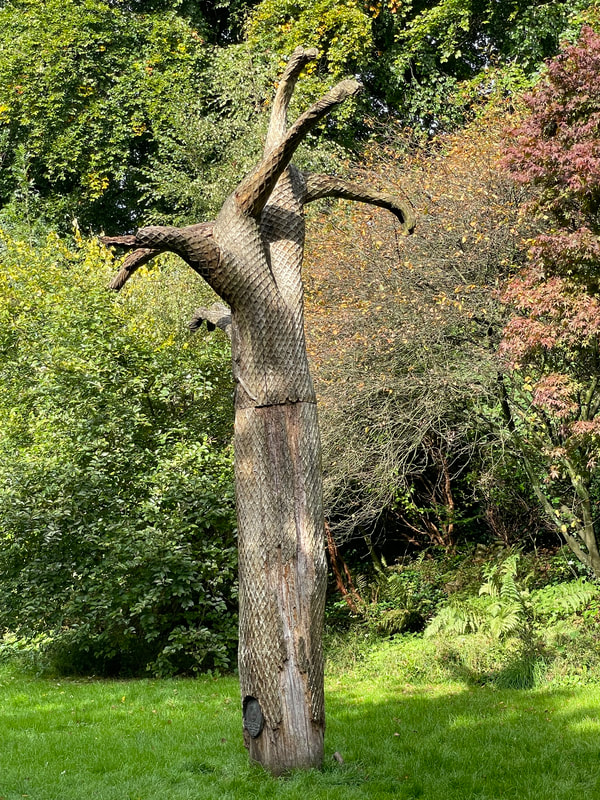|
Since March 2020, at the beginning of the first lockdown, I've been taking photos on my daily walks. These have been mostly of flowers, trees, and nature in general, that catch my eye as I wander around my neighbourhood and local park. Eventually I began sharing these daily photos on social media, namely Facebook and Twitter (will always be Twitter to me), and I've loved the dialogue that this created with some people who follow me. I love hearing what others notice in my photos. Recently, however, I've been wondering if it's time to stop?
I've been through all seasons now at least 3 times; capturing nature in Spring, Summer - what little there is of it here in Scotland - Autumn, and the long dark days of Winter. However, I've begun to recognise a slight but signifiant shift in me. It seems that I'm no longer seeing things with fresh eyes. Instead, I'm noticing what might make for a lovely photo. I think they call that 'an instagram moment'! I'm 'looking' rather than 'seeing' and, experientially, that is very different. It feels more 'performative' and, consequently, less wondrous. So it's time to take a break or stop altogether, who knows. Only time will tell. In the #LDI leadership retreat work that I and others are privileged to do, we will ask: 'What is it time for now?' We are, of course, talking about the 'kairos' sense of time - meaning time that is measured not in seconds or minutes but in moments or experiences. What is this the opportune or right time for now? When I ask myself that question this is what emerges for me. I want to spend more time taking photographs but not with the sole intention of sharing those pictures with others, seeking acknowledgement or recognition or whatever the 'hit' is that I get from doing so. The process of taking photographs began as an inward focussed experience - a kind of internal dialogue - that I was then happy to share with others. I want to return to that. It feels the right time to do so and the right thing to do. I will continue to share photos, as and when, but it will be a secondary act and not the primary one. What is it time for now, for you? What do you hear yourself answering when you pose this question? Autumn, after all, is a time for letting go. What might you need to let go?
0 Comments
This is the last in the current series of my articles on Dr John Scherer's "Five Questions that change everything".
Q1: What CONFRONTS you? Q2: What are you BRINGING? Q3: What RUNS you? Q4: What CALLS you? Q5: What will UNLEASH you? These five questions form the central design around which the generative and transformational leadership development intensive (LDI) is designed. You can find my reflections on the previous four questions here As we come to the conclusion of the LDI, or indeed, our exploration of the powerful questions, I reflect here on Q5:
In his book, 'FIVE QUESTIONS THAT CHANGE EVERYTHING': LIFE LESSONS AT WORK, John writes that both pain and possibility are essential ingredients for transformation, one without the other is not sufficient. He states that for 'fundamental change to take place in your life, you must:
As I reflect on this question and John's points above, I am reminded of such a moment in my own life when I first attended the Tavistock Institute's Leicester Conference (LC). The LC is not a 'conference' in the conventional sense of the word. There are no keynote speakers, no seminars or workshops. It is a deep experiential event held over 14 days, in which members and staff alike explore what it means to exercise authority, and take up leadership and followership roles in the service of a primary task within a temporary institution. Without the familiar structures associated with a conference, members and staff are confronted time and again with not knowing. There are invariably moments when it is a challenge to hold on to one's sense of self or a sense of reality. This is intended to offer up opportunities for learning about ourselves as well as group and organisational dynamics. During the 2nd week of this particular conference I felt overwhelmed and, quite frankly, lost. I couldn't think clearly, I had no idea what I was trying to do or what I was supposed to be learning. It seemed to me that I was stuck in an all too familiar rut of self doubt and confusion, while watching everyone appear to be absorbed in action and seemingly knowing what they were doing! I decided to get outdoors and take a walk around the garden grounds to get away from it all. Initially I was full of self reproach but as I slowed down and allowed myself to fully acknowledge my feelings of overwhelm, confusion, and self judgement, I gradually felt myself surrendering, letting go of my need to know, to understand or even to pull myself together. I gradually experienced a gentle self compassion. For a brief moment my world slowed down and I entered a kind of liminal space. What was most surprising for me was that at the very moment I began to let go, to simply BE, an idea began to crystalize in my mind, an idea about some small experiment I could make within the experiential event that would further my learning. I relaxed, felt mobilised and able to return to the group with a sense of agency. Over these last few years, I've learned to trust these kinds of experiences. As I have reflected further on this, I am reminded of the deeply powerful words of Dr James Finley, spiritual writer, and Pscyhotherapist: "Do not break faith with what your awakened heart knows to be true." Keeping faith with what's awakened in me is what continues to UNLEASH me? Photo 117127055 / Free © CristinaConti | Dreamstime.com I had the pleasure of interviewing my good friend and mentor, Dr. John J. Scherer, on the #LDI . We discuss how the #5Questions came to be, what prospective participants on the LDI can expect to gain from their experience, and why it's always a perfect time to do an LDI. John will be joining myself and Günter Westphal in facilitating the LDI in Scotland in May (9th-12th) This is a rare opportunity for us to experience firsthand the immense wisdom John brings to this work he created over 30 years ago and which has now been delivered in over 55 countries. The video is just over 9 minutes, with a glitch from my good self mid-way through - I'm only human 😁 It is worth seeing the whole conversation. #leadershipdevelopment #personaldevelopment #transformation For the last two year or more I've been taking photographs on my daily walks: photographs of flowers, birds, trees, landscapes, sunrises, sunsets, you name it. Whatever catches my eye. What began as something to focus on during those early days of lockdown has evolved into a daily practice of noticing. This, in turn, has helped develop a much richer internal dialogue; I converse with myself about what is evoked in me through what I notice. Through this practice I'm coming to a greater appreciation that everything is transient, including or perhaps especially, my inner world of thoughts, feelings and emotions. Noticing this is encouraging me to stay open to different possibilities and outcomes.
In the LDI programme, a deeply creative personal leadership programme developed by Dr.John Scherer, we encourage leaders to 'notice what you notice' as well as, at times, to ask: 'what might I be missing?' Paradoxically, noticing what we're not noticing can be hugely insightful too. But more of that later. Earlier this week, on one my daily walks, my eyes were drawn to the flowers captured in this collage.. As I reflected on the image, I noticed I was attracted to their 'lightness'; and the phrase 'lightness of being' surfaced with a strong resonance within me. I realised that the idea of 'lightness' stood in sharp contrast to the seriousness and heaviness of what was happening both in me and around me. The image felt like an invitation to 'lighten up', to engage and respond to the events and situations that confront me in a lighter way despite the gravity of the moment. It struck me that this lightness is precisely what is being called for in my leadership right now. Do you have a practice of noticing? Do you notice what you notice? If so, how do you attend to what you notice? Everywhere I turn, liminal spaces beckon me,
Can I hold the tension Resist the urge to forge conclusions Stay alive to my seeking, not so much to understand, trusting the ground on which I stand This in-between is where I need to BE Let it capture me … This morning, as I took my usual early morning walk with the dog, I was struck by the contrasting feelings inside me. On the one hand, I felt touched by the beautiful morning sun as it reflected on the houses in my neighbourhood. It evoked a sense of wonder in me. At the same time, however, like so many, I felt deeply disturbed by events taking place just over 2,000 miles away in Ukraine. I don't know enough about how we got here to pontificate, but I do know that I feel scared, angry and sad.
I've spent the best part of this week working with groups in organisations - and inter-organisational - helping them to talk with each other about their working relationships: how the different and often competing demands and pressures impact the way they relate to and see each other and what is needed to keep them communicating, especially during the periods of heightened stresses and tensions. Being in the room together, face to face, listening, talking, laughing together, helps reduce the projections of 'us' and 'them'. More than ever, we need to keep talking ... because when the talking stops things can get serious, and dangerous, very quickly. In this mini blog series, I explore Dr John Scherer’s 5 powerful questions designed to develop the PERSON in life and leadership:
1.What CONFRONTS you? 2.What are you BRINGING? 3.What RUNS you? 4.What CALLS you? 5.What will UNLEASH you`? In the first two blogs, I explore Q#1, and Q#2 + #3 together, respectively. These questions, in and of themselves, can help to deepen our insight into our own leadership. Facing what CONFRONTS us and exploring what it is we BRING to the issues or situations we find most challenging, can lead us to powerful insights about what RUNS us and thus open up greater possibilities for how we choose to respond. Q#4: What CALLS you? takes our inquiry to a whole other level. This question can upend our current way of living and working; it can also bring us a greater sense of purpose and peace. The idea that life ‘calls’ us, is something many of us associate with people of faith or religion but it is not the preserve of the few. John Scherer invites us to consider the question through these sub questions: What calls out to you from the world? What is a need that exists ‘out there’ that grabs you and won’t let you go? What situation in Life are you perfectly designed to address? In thinking about these questions recently, my thoughts turned to an earlier period in my career. Many years ago, while working as the Learning and Development Manager for a large children’s charity, I felt motivated by a desire to work to build and develop a learning culture in the organisation that could better support managers and their teams to carry out the emotionally demanding work with children, young people and their families who faced significant adversities. I had been one of those managers and, prior to that, had been one of the field workers undertaking the direct work with young people for many years. I understood only too well the challenge of the work and the feelings of responsibility to, at the very least, not do any harm. I wanted to make a difference to those doing the work, believing that would support them in their efforts to make a difference for the families they worked with. And so, for eight years, without thinking about it too much, I pursued this vision with others in my team and the wider organisation. The work was rich and rewarding and we enjoyed some success but, ultimately, it proved difficult to sustain. A change of leadership, accompanied by changes in organisational priorities undone a lot of the good work. And it was time for me to move on. For a long time after leaving that role, I did not experience the same drive or motivation; work did not hold the same meaning for me. Somewhere along the way – probably before I left the Charity – I lost my conviction about the real prospect of lasting change. The company I worked with at that time was going through its own financial challenges and it, too, had questions about its mission and purpose in the world. Some days it was difficult to get myself out of bed in the morning. This was not the case every day, but it was the case often enough for me to know that something wasn’t quite right for me but I didn’t know what it was or what to do about it. I recall a dream I had during this time which occurred as I was coming to the end of a 4-week family holiday in Australia and had begun to experience a sense of dread at the prospect of returning to work. In the dream I was speaking to a good friend and mentor. I excitedly told him that I had FINALLY worked out what my life’s goal was, and proudly declared: ‘my goal is not to have a goal!’ ‘How very zen’, he said and laughed with delight. I remember the sense of relief I felt after waking that morning and the days and weeks that followed; it was as if a cloud had lifted. There are, I’m sure, many ways in which the dream could be interpreted but, for me at that time, I understood it to be an invitation to let go; to let go of the need to find my ‘one single purpose’ in life. Instead, I felt invited to simply choose to be as fully present in the work I was doing as it was possible for me to be. My attitude towards my work changed significantly; I felt lighter, curious again and a good deal more creative. Paradoxically, by letting go of the apparent need to have a purpose, what has emerged over time is an ever-growing and deepening commitment to work much more in the moment - whether that is working with organisation leaders in my coaching work, or with teams in my consultancy or facilitation work. This means really noticing what is being said, conveyed or experienced in the conversations and remaining curious about the meaning or significance of that for the tasks at hand. It is during these times that I feel most alive. I believe it is from these deeper sense-making spaces that we are more able to identify meaningful action based on real insight. It is not only in my work that I find being in the moment the place to be. Throughout the coronavirus pandemic and during the various lockdowns, I found myself developing a daily practice of taking photographs of my local neighbourhood and of nature around me. Through my camera, or iPhone, I capture what catches my attention, stops me in my tracks, or calls out to me in some way. This daily practice has gathered a momentum of its own, developing in me a greater curiosity and appreciation of the quality of life – and death – that surrounds me moment to moment. I don’t know where this is leading but it feels right to be paying attention in this way. It occurs to me now that the notion of lasting change that I once felt so convinced of, and longed to rediscover in my work, and life, is an illusion. All we can be certain of is what is happening here and now. I want to commit to that, to notice it and be curious about the possible meaning and significance it holds for me and others. This is what calls me, and it is also what will UNLEASH me – Q#5. What CALLS you? What will UNLEASH you? What are you ‘perfectly-designed’ to address in the world? Last week I wrote the first in a series of short blogs about John Scherer’s Five Powerful Questions that can transform your life and your leadership, focussing specifically on Q#1: What CONFRONTS you? You can access that blog here. In this blog, I will address Q#2: What am I BRINGING? and Q#3: What RUNS me? These questions relate to the ‘tigers’ in our life that we choose to either turn and run away from or face with courage. Questions #2 and #3 lead us into a discovery process about what makes the tiger a tiger for us.
Turning and facing a ‘tiger’ requires a certain kind of curiosity about oneself as well as courage. We start by reflecting on the particular ‘tiger’ situation that confronts us and ask ourselves, ‘what am I BRINGING to this situation?’ Allow me to share a personal example: A recent ‘tiger’ situation that I faced was that of promoting my work, and thus by definition, promoting myself. Although, this is a necessity if I wanted to get my work out into the world and to grow and develop my Leadership & OD consulting business, the thought of self-promotion of any sort filled me with dread. Writing this series of blogs is, of course, one example of such self-promotion. When faced with a tiger – a situation we’d do anything to avoid – it helps to explore what lies behind our wish/need to turn and run and to ask ourselves, 'what am I bringing to the situation that makes it a tiger for me? What are my hopes, my fears and my history with this? My hope is that in promoting my work I am to able to convey the significance of the meaning of something for me that will resonate with others - enough for them to want to work or collaborate with me. At the same time, however, I fear, that what I promote may be quickly dismissed as a form of shameless self-promotion and deemed irrelevant. This is an example of the kind of internal conversation that I would all too easily have with myself. Many of us know this ‘inner critic’ all too well. As I reflected on Q# 3: what’s been RUNNING me in relation to this particular tiger, an interesting memory from my early adolescence came to mind. When I was about twelve years old I joined a Latin American dance class, which I attended twice weekly and regularly participated in dance competitions. I was not ‘naturally talented’. I had to work hard. I watched all the winning dancing couples to see what I could learn from them. I noticed something about the way they carried themselves; their confidence and cockiness, particularly the way they moved their heads as they danced the rumba, samba, and cha cha cha. If you’ve watched ‘Strictly Come Dancing’ or some other similar dance competition programme, then perhaps you can imagine what I’m talking about? I thought this was key to their success and so I started copying them in my dance routines with my dancing partner. I’d shake my head this way and that, as I danced around the ballroom floor. It seemed to get me noticed and it wasn’t too long till we won our first bronze medal! I was feeling chuffed with myself. However, on returning to my dance class one week after a competition, my dance teacher remarked, in front of the class, “If you shake that head of yours any harder, it will come off your body!” I immediately felt embarrassed and my fragile confidence crushed. Looking back on it with the benefit of hindsight, I don’t think his intention was to embarrass me. Perhaps he was trying to prevent me from making a fool of myself? Sure, he could have handled it better, but previously I had only felt encouraged by him. However, put his 'feedback' in the context of the culture of a working class, West of Scotland, where it was not okay to get ‘too big for your boots’, or ‘show off’, then the message that I internalised - that any form of self promotion is shameful and is to be avoided - begins to make sense to me. I could now better understand what makes this a tiger for me and that understanding helps create new and different possibilities for me. Why does this matter? In 'Half a Shade Braver: the foundations of conversational leadership', poet and author, David Whyte, asserts that 'leadership is about being seen'. If I/we want to create something in the world, or to make a difference in our work, relationships and life, we need to bring all of our leadership to the pursuit of what matters to us and that means allowing ourselves to be seen. In my final blog in this series I will address Q#4: What CALLS you? and Q#5 What will UNLEASH you. If you're interested to find out more about these Five Questions or the Leadership Development Intensive get in touch with me: pauline@limenassociates.co.uk The Leadership Development Intensive (LDI) created by Dr John J Scherer, is designed around 5 powerful and transformative questions:
1. What CONFRONTS you? 2. What are you BRINGING? 3. What’s RUNNING you? 4. What CALLS you? 5. What will UNLEASH you? I am updating and re-sharing a series of short blogs to illustrate how these inquiry questions help to generate new and deeper insights into who we are and how we show up in our leadership, creating greater possibilities for action that result in surprising outcomes. In this blog, I’m going to address Q#1 – what CONFRONTS you? We don’t need to think too hard about what confronts us at the moment at the collective level! On the back of a pandemic, in the UK where I live, we are now facing into a full blown cost of living crisis, growing unrest and industrial action across public and some private sector organisations, a crisis of confidence in our large institutions from politics to police, to residential care services where societies most vulnerable members are supposed to be looked after. Increasingly, we are looking for leadership at all levels in our communities, organisations and wider society to help us navigate the significant uncertainties we face. But what kind of leadership is called for? What kind of leadership is needed NOW? I believe that, more than ever, the PERSON in the POSITION of leadership matters. Who you are, and how you lead, is central to establishing and maintaining the trust needed to bring people together to find new and lasting solutions for the world we live in. So, bringing the challenge of leadership closer to home and gaining insight in to your leadership starts with Q#1: identifying what situation(s) CONFRONTS you in your life and/or leadership that up till now you’ve been avoiding? For example, perhaps you prefer to avoid:
If you’d like to chat about these 5 questions or find out more about the LDI, then get in touch with me: pauline@limenassociates.co.uk |
Pauline HollandPassionate about being with things as they are, not as we would want them to be. Writing about the things that matter to me and that might resonate with you. Archives
October 2023
Categories |












 RSS Feed
RSS Feed
